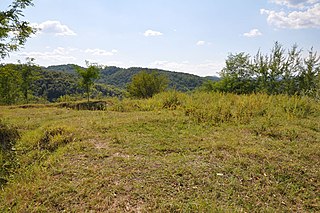
Jurilovca is a commune in Tulcea County, Northern Dobruja, Romania. It is composed of three villages: Jurilovca, Vișina and Sălcioara.

Argamum was originally an ancient Greek city in Scythia Minor founded by Greek colonists from Asia Minor on the coast. It is located on Cape Dolosman in Romania near Jurilovca on the coastal lagoon that in ancient times was the open sea.

Buridava (Burridava) was a Dacian town situated in Dacia, later Dacia Apulensis, now Romania, on the banks of the river Aluta, now Olt.

Arutela was an ancient Roman fort in the Roman province of Dacia today near the town Călimănești. It lies on the left bank of the Olt River. It was part of the Roman frontier system of the Limes Alutanus,

Tibiscum was a Dacian town mentioned by Ptolemy, later a Roman fort and municipium. The ruins of the ancient settlement are located in Jupa, Caraș-Severin County, Romania.

Micia was a large Roman fort for auxiliary troops and town nearby. The archaeological site is located in the municipality of Vețel (Witzel), Hunedoara County in Transylvania, Romania.

Resculum was an ancient Roman fort in the Roman province of Dacia.

Castra of Boroșneu Mare was a fort in the Roman province of Dacia in the 2nd and 3rd centuries AD. A contemporary settlement was also unearthed at the fort. Its ruins are located in Boroșneu Mare in Romania.
It was a fort in the Roman province of Dacia and part of the Roman frontier system of the Limes Transalutanus.
The castra of Crâmpoia was a fort in the Roman province of Dacia. It was made of earth in the 2nd century AD. The Romans abandoned the fort in the 3rd century. Its ruins are located in Crâmpoia, Romania.

The castra of Cincșor was a fort in the Roman province of Dacia in the 2nd and 3rd centuries AD and part of the frontier system of the Limes Alutanus.
The castra of Drumul Carului was a fort in the Roman province of Dacia near Moieciu, Romania.

Apulum was a legionary fortress in the Roman province of Dacia from the 2nd to 4th centuries AD, located in today's Alba Iulia, Romania.
The castra of Fâlfani was a fort built in the 2nd century AD in the Roman province of Dacia. It was part of the Roman frontier system of the Limes Transalutanus.

Gresia Roman fort is located in the present Gresia. It was in the Roman province of Dacia and dates from the 2nd and 3rd centuries AD. It was part of the frontier system of the Limes Transalutanus.
The Castra of Izbășești was a fort made of earth in the Roman province of Dacia. Erected and abandoned at an uncertain date, the fort was part of the Limes Transalutanus. Traces of the one time earthwork can be identified on the Corbeasca Hill at Izbășești.
The castra of Livezile was a castra in the Roman province of Dacia, located in the north side of the modern commune of Livezile in the historical region of Transylvania, Romania. The fort was erected and surrounded by a ditch in the 2nd century AD. The castra was abandoned in the 3rd century and its ruins are still visible.

Although not unanimously accepted, the existence of the castra of Cristești in the Roman province of Dacia is substantiated by bricks and tiles bearing the name of a Roman military unit, the Ala I Gallorum et Bosporanorum. The lack of any other traces of the Roman fort may easily be due to its destruction by the Mureș River. At Cristeşti, a Roman settlement from the 2nd and 3rd centuries AD was unearthed which was an important center of potters.
The Castra of Jac was a fort made of earth in the Roman province of Dacia. It was erected in the 2nd century AD. Not far from the fort, the remains of a previous fortification and of a Roman watchtower were unearthed. The fort and the watchtower were abandoned in the 3rd century. Traces of the castra can be identified on Citera Hill in Jac.
This page is based on this
Wikipedia article Text is available under the
CC BY-SA 4.0 license; additional terms may apply.
Images, videos and audio are available under their respective licenses.











